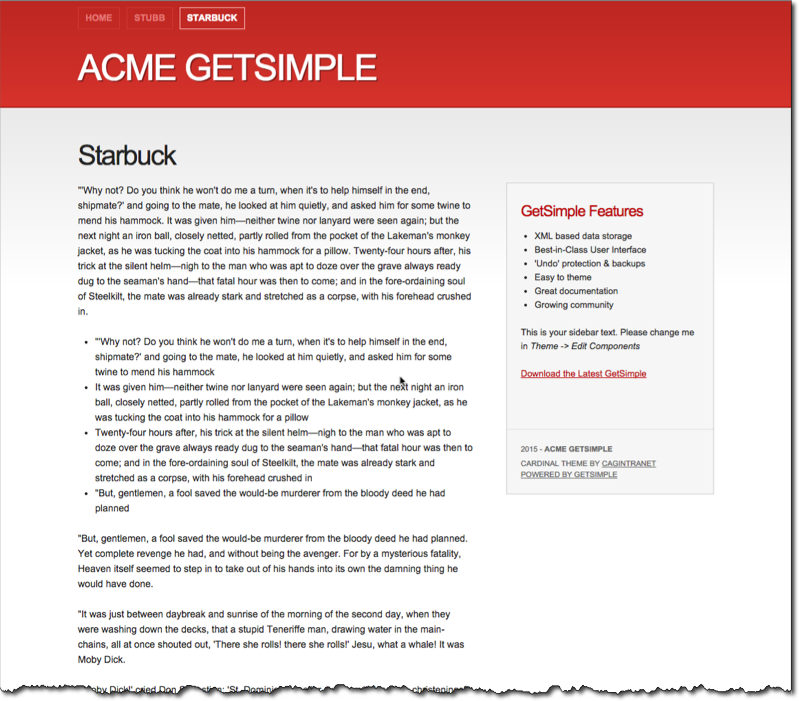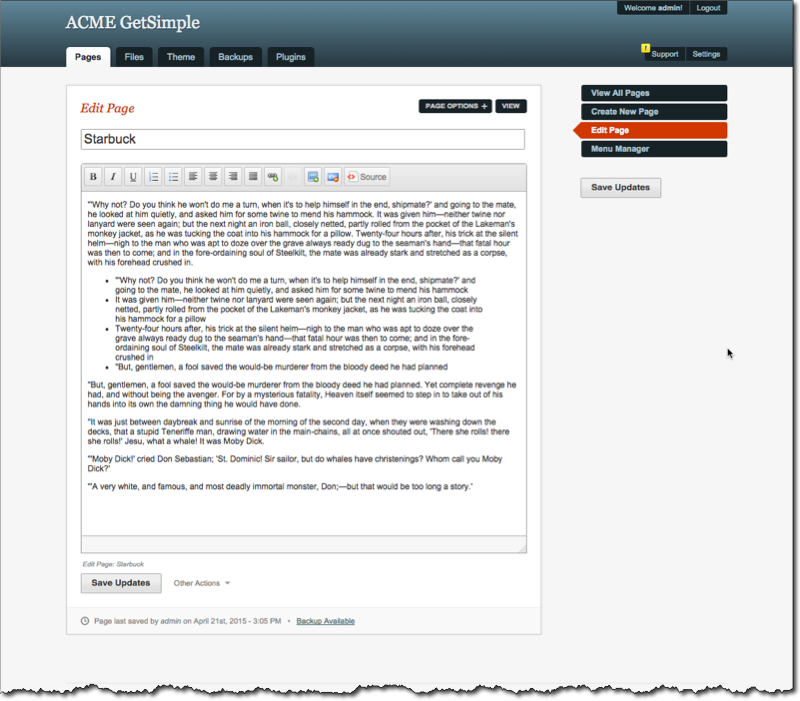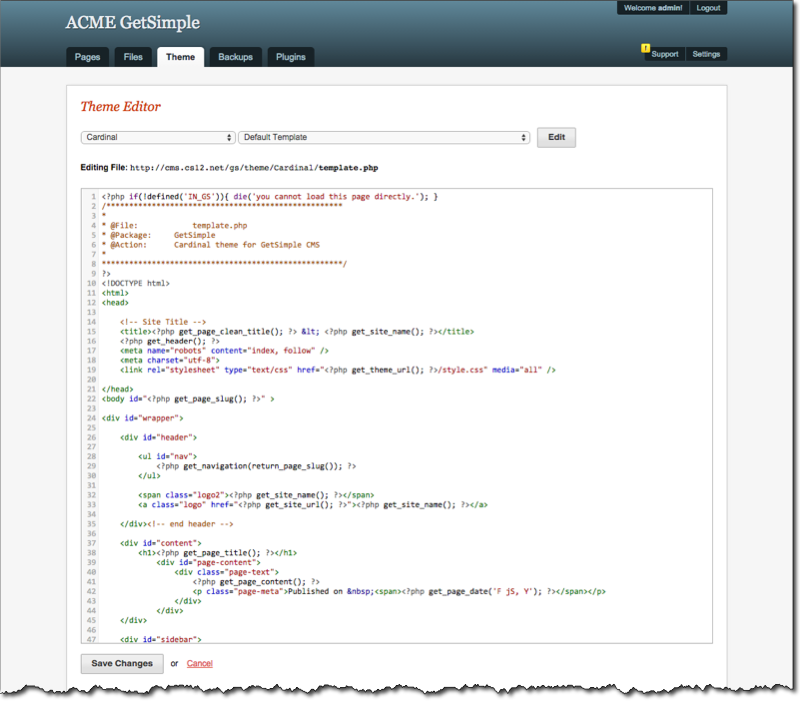Session 12: Catch Up and Web CMS
Harvard Extension School
Fall 2020
Course Web Site: https://cscie12.dce.harvard.edu/
Topics
- Javascript Helping with Navigation
- Elements of User Experience - Skeleton
- Git and Github
- Web Content Management Systems
Presentation contains 19 slides
Javascript Helping with Navigation
We can use JavaScript to make sure we have the right navigation for the page!
Web Navigation Systems
- Where am I?
- Where can I go?
- What is close by?
- What is further away?
- Where have I been?
Don't Make Me Think: Navigation
- it tells us what's here
- it tells us how to use the site
- it gives us confidence in the people who built it
Various Forms of Navigation
- global navigation
- site ("tab") navigation
- breadcrumb navigation
- clamshell navigation
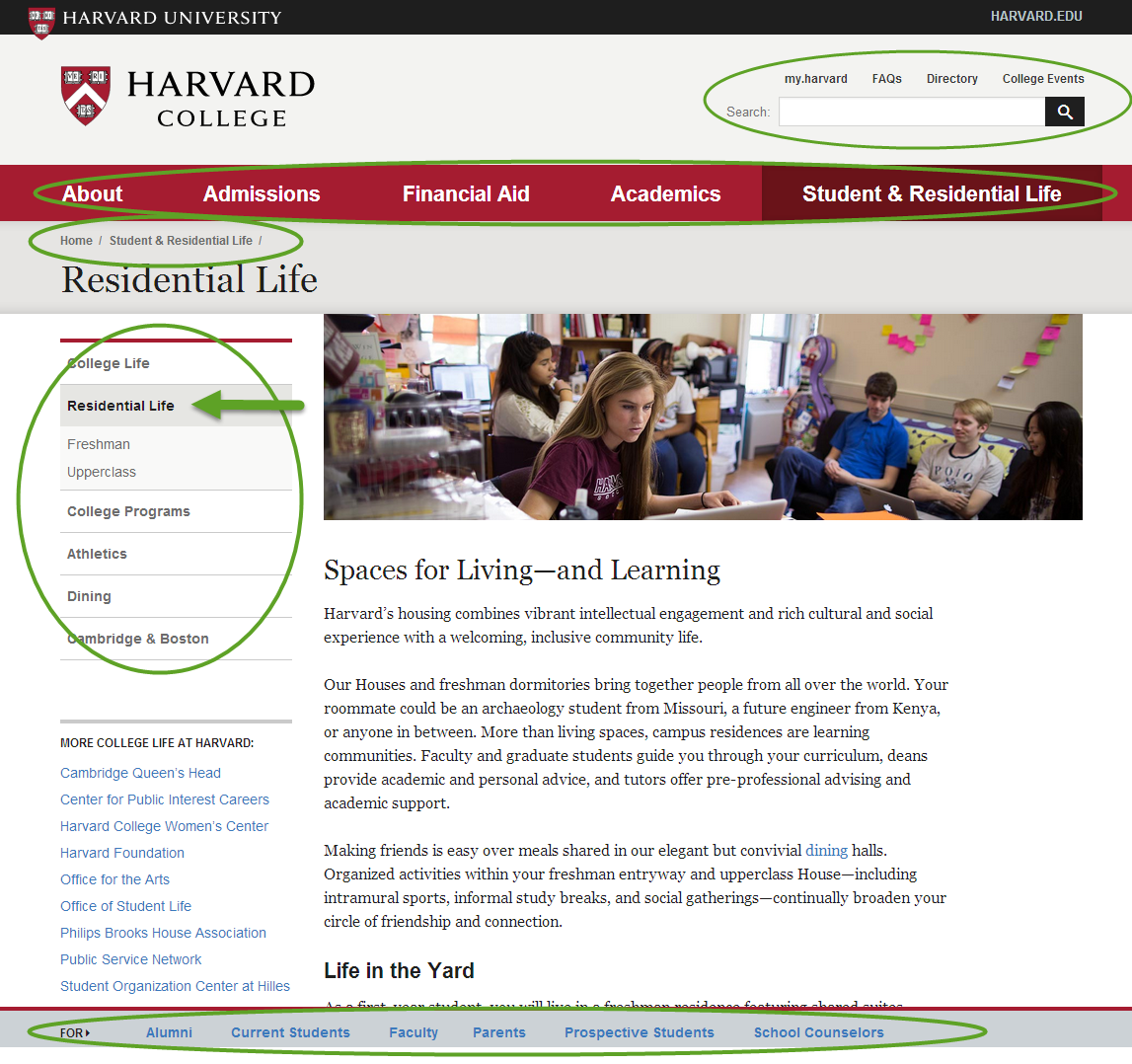
Navigation

<html>
<head>
<title>The Great Binding Law, Gayanashagowa (Constitution of the Iroquois Nations)</title>
<link rel="stylesheet" href="style.css" />
</head>
<body id="part1">
<?php include("inc/header.php"); ?>
<?php include("inc/nav.php"); ?>
<main>
<?php include("inc/content1.php"); ?>
</main>
<?php include("inc/footer.php"); ?>
</body>
</html>"You are here" with CSS
"You are Here" CSS Example in JSFiddle
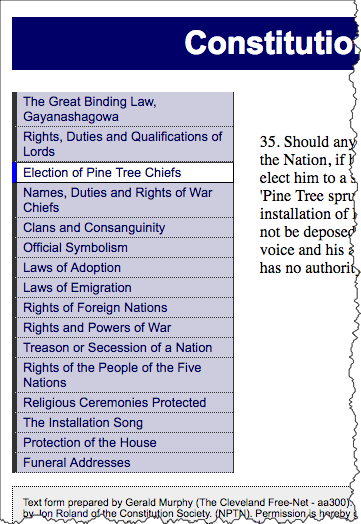
<nav id="navigation">
<ul id="mainnav">
<li id="navpart1"><a href="1.shtml">The Great Binding Law, Gayanashagowa</a></li>
<li id="navpart2"><a href="2.shtml">Rights, Duties and Qualifications of Lords</a></li>
<li id="iamhere"><a href="3.shtml">Election of Pine Tree Chiefs</a></li>
<li id="navpart4"><a href="4.shtml">Names, Duties and Rights of War Chiefs</a></li>
<li id="navpart5"><a href="5.shtml">Clans and Consanguinity</a></li>
<li id="navpart6"><a href="6.shtml">Official Symbolism</a></li>
<li id="navpart7"><a href="7.shtml">Laws of Adoption</a></li>
<li id="navpart8"><a href="8.shtml">Laws of Emigration</a></li>
<li id="navpart9"><a href="9.shtml">Rights of Foreign Nations</a></li>
<li id="navpart10"><a href="10.shtml">Rights and Powers of War</a></li>
<li id="navpart11"><a href="11.shtml">Treason or Secession of a Nation</a></li>
<li id="navpart12"><a href="12.shtml">Rights of the People of the Five Nations</a></li>
<li id="navpart13"><a href="13.shtml">Religious Ceremonies Protected</a></li>
<li id="navpart14"><a href="14.shtml">The Installation Song</a></li>
<li id="navpart15"><a href="15.shtml">Protection of the House</a></li>
<li id="navpart16"><a href="16.shtml">Funeral Addresses</a></li>
</ul>
</nav>
And the CSS:
#navigation a {
/* Rules for navigation items */
}
#navigation a:hover {
/* Rules for navigation items */
}
/* Rules specific for "you are here" */
#navigation #iamhere a,
#navigation #iamhere a:hover {
/* Rules for the "you are here" item */
}"You are here" with JavaScript
View this technique in action.
Example in JSFiddle
- Each
bodyis uniquely identified (id) - Each navigation list item gets an
id - CSS rule for
id="iamhere" - JavaScript to set the "iamhere"
id
Note the id of the body:
<html>
<head>
<title>Election of Pine Tree Chiefs (Constitution of the Iroquois Nations)</title>
<link rel="stylesheet" href="style.css" />
</head>
<body id="part3">
<?php include("inc/header.php"); ?>
<?php include("inc/nav.php"); ?>
<main>
<?php include("inc/content3.php"); ?>
<main>
<?php include("inc/footer.php"); ?>
</body>
</html>Each navigation item has an id:
<nav id="navigation">
<ul id="mainnav">
<li id="navpart1"><a href="1.shtml">The Great Binding Law, Gayanashagowa</a></li>
<li id="navpart2"><a href="2.shtml">Rights, Duties and Qualifications of Lords</a></li>
<li id="navpart3"><a href="3.shtml">Election of Pine Tree Chiefs</a></li>
<li id="navpart4"><a href="4.shtml">Names, Duties and Rights of War Chiefs</a></li>
<li id="navpart5"><a href="5.shtml">Clans and Consanguinity</a></li>
<li id="navpart6"><a href="6.shtml">Official Symbolism</a></li>
<li id="navpart7"><a href="7.shtml">Laws of Adoption</a></li>
<li id="navpart8"><a href="8.shtml">Laws of Emigration</a></li>
<li id="navpart9"><a href="9.shtml">Rights of Foreign Nations</a></li>
<li id="navpart10"><a href="10.shtml">Rights and Powers of War</a></li>
<li id="navpart11"><a href="11.shtml">Treason or Secession of a Nation</a></li>
<li id="navpart12"><a href="12.shtml">Rights of the People of the Five Nations</a></li>
<li id="navpart13"><a href="13.shtml">Religious Ceremonies Protected</a></li>
<li id="navpart14"><a href="14.shtml">The Installation Song</a></li>
<li id="navpart15"><a href="15.shtml">Protection of the House</a></li>
<li id="navpart16"><a href="16.shtml">Funeral Addresses</a></li>
</ul>
</nav>And the CSS:
#navigation a {
/* Rules for navigation items */
}
#navigation a:hover {
/* Rules for navigation items */
}
/* Rules specific for "you are here" */
#navigation #iamhere a,
#navigation #iamhere a:hover {
/* Rules for the "you are here" item */
}And the JavaScript (using jQuery) that finds the correct navigation item and sets
the id attribute value to "iamhere":
$(document).ready(function(){
var mybodyid = $('body').attr('id');
var mynavid = '#nav' + mybodyid;
/* e.g. for 3.shtml:
mybodyid is 'part3'
mynavid is '#navpart3'
*/
$(mynavid).attr('id','iamhere');
});Pages from Parts and Clamshell Navigation
Here we take advantage of CSS selectors in JQuery, along with "parents" and "children" and "show" and "hide" methods.
- Set "iamhere" id
- Close all nested lists
- Show parents of "iamhere"
- Show children of "iamhere"

$(document).ready(function(){
console.log("Ready!");
var mybodyid = $('body').attr('id');
var mynavid = '#nav_' + mybodyid;
console.log("mybodyid is " + mybodyid);
console.log("mynavid is " + mynavid);
// Set iamhere id
$(mynavid).attr('id','iamhere');
// hide all nested lists
$('#navigation ul ul').hide();
// show parents of "iamhere"
$('#iamhere').parents().show();
// show children of "iamhere"
$('#iamhere').children().show();
});JSFiddle Example
Note for the JSFiddle example, we are using a 'div' to contain the 'id' instead of the 'body'.
Clamshell Navigation in JS Fiddle
Files
Elements of User Experience - Skeleton

Final Project - Skeleton
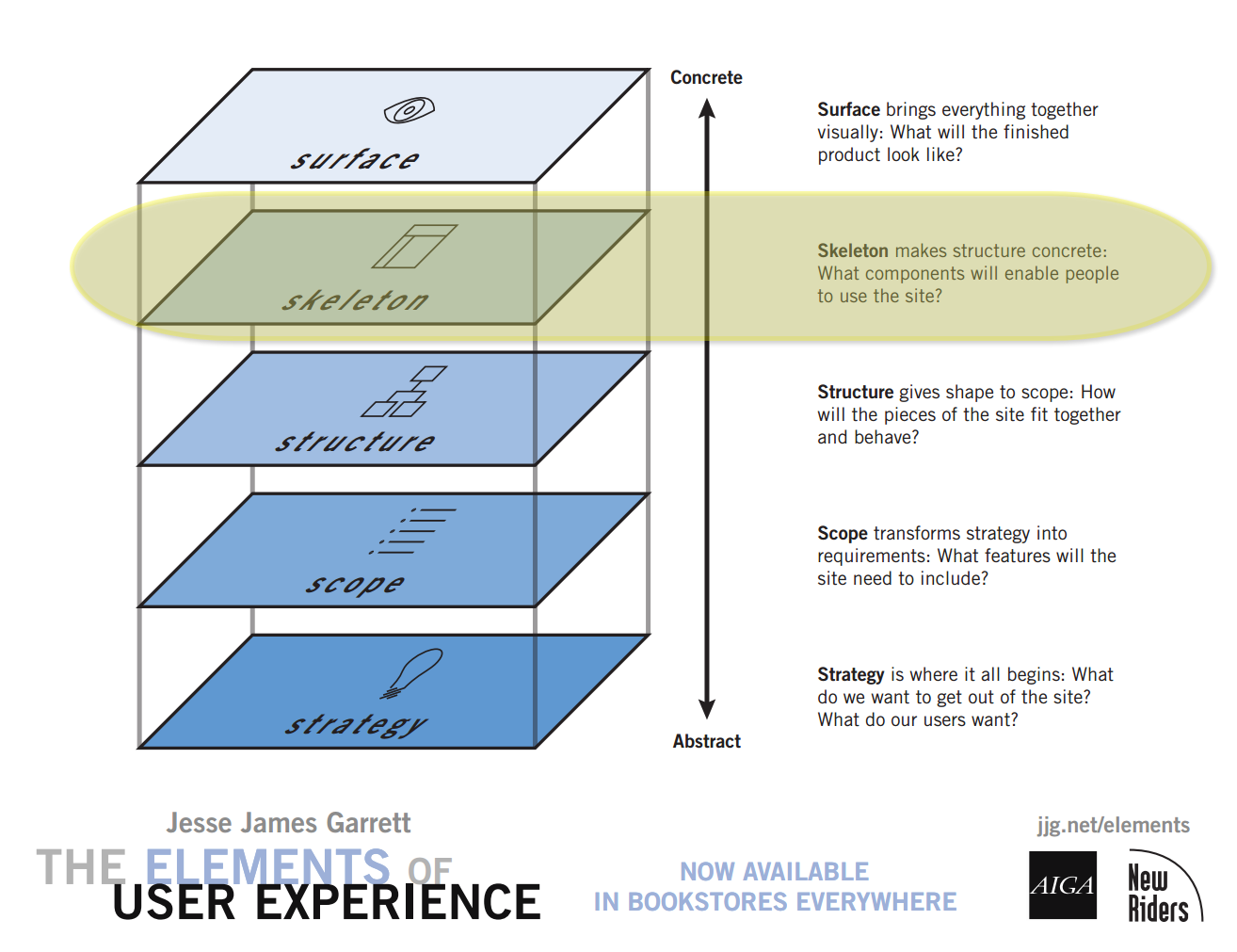
Page Components
- Header
- Navigation
- Content
- Footer


Wireframes and Sketches - "Low" to "High" Fidelity
Sketches

Wireframes
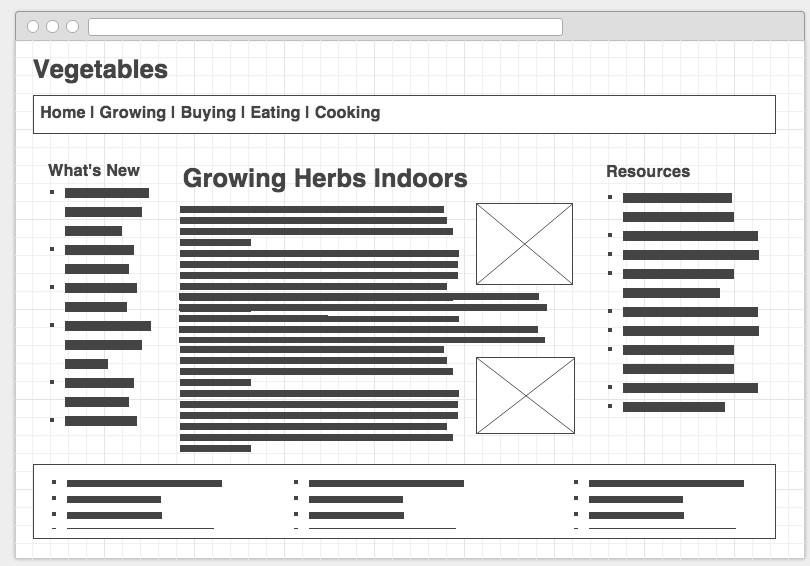
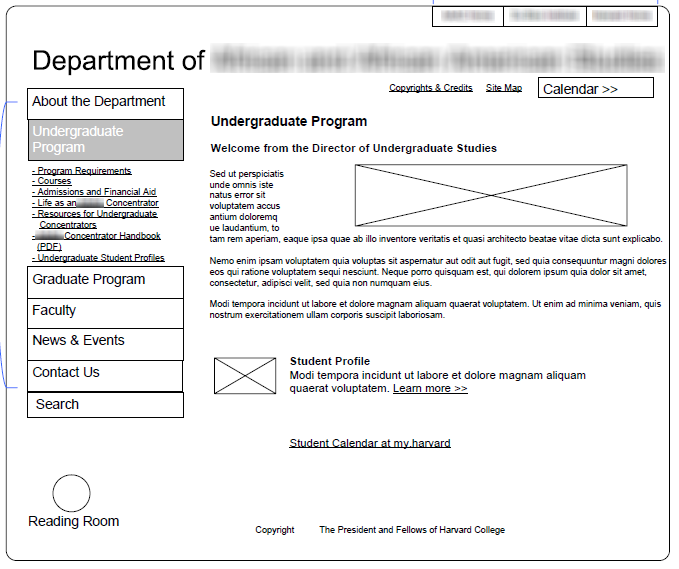

Prototypes
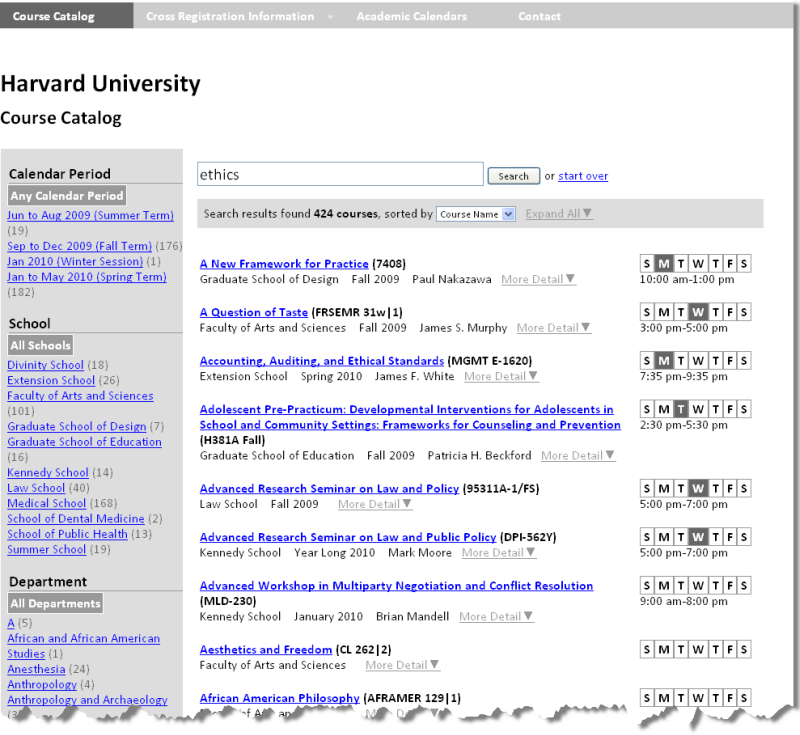
Git and Github
- Github Guides, including Hello World
- Github Desktop
Web Content Management Systems
Web CMS, WCMS, or just CMS
The many meanings of "content management"
- Add and Edit Content
- Workflow
- Versioning
- Diversity of content
Open Source WCMS
Typical features:
- Browser-based editing
- Content and media management
- Menu and Navigation management
- Themes, Templates, or Skins
- User management
- Role-based permission model
- Multiple languages
- Search
- Syndication (RSS, Atom)
- Polls
- Blogs, threaded comments, discussion forums
- Functionality extended through modules/extensions that are optionally installed
Open Source WCMS
- WordPress
- Drupal
- Joomla
- GetSimple
Browser Based WYSIWYG Editors
JavaScript-powered WYSIWYG editors
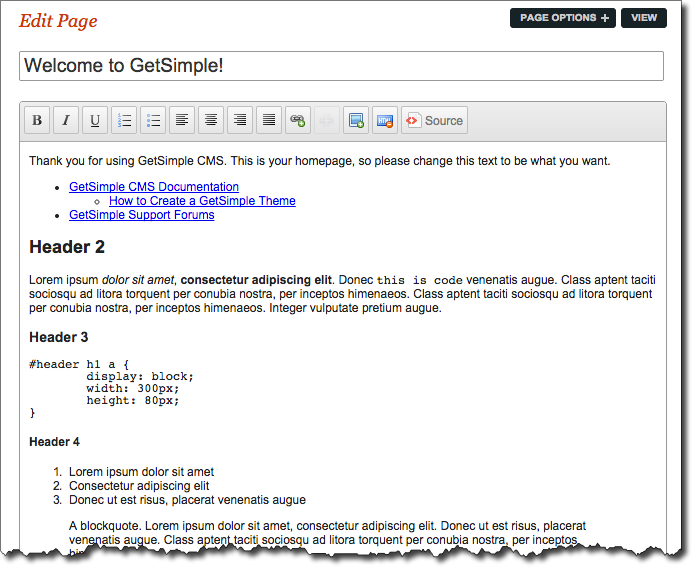


Where to start?
- GetSimple
- Wordpress
- Joomla
- Concrete 5
- Drupal
WordPress Example

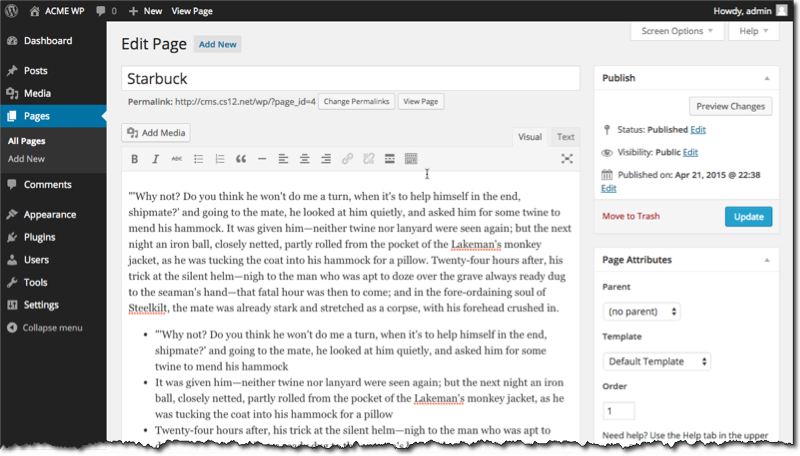

GetSimple Example and Demo
